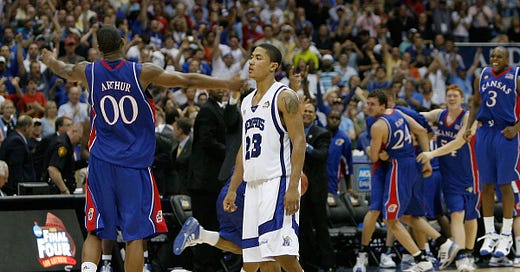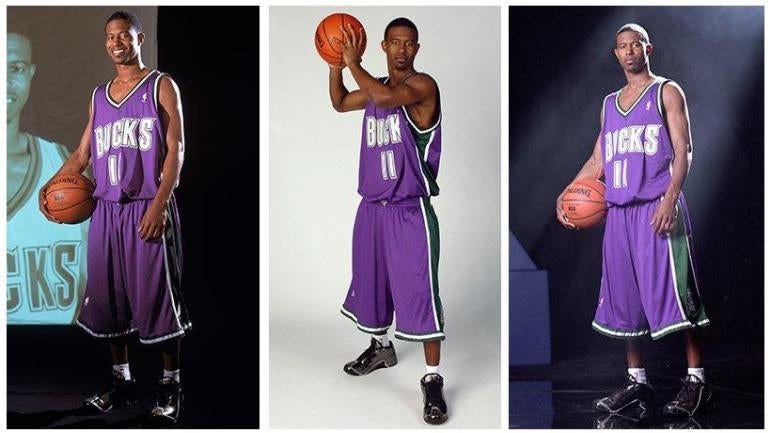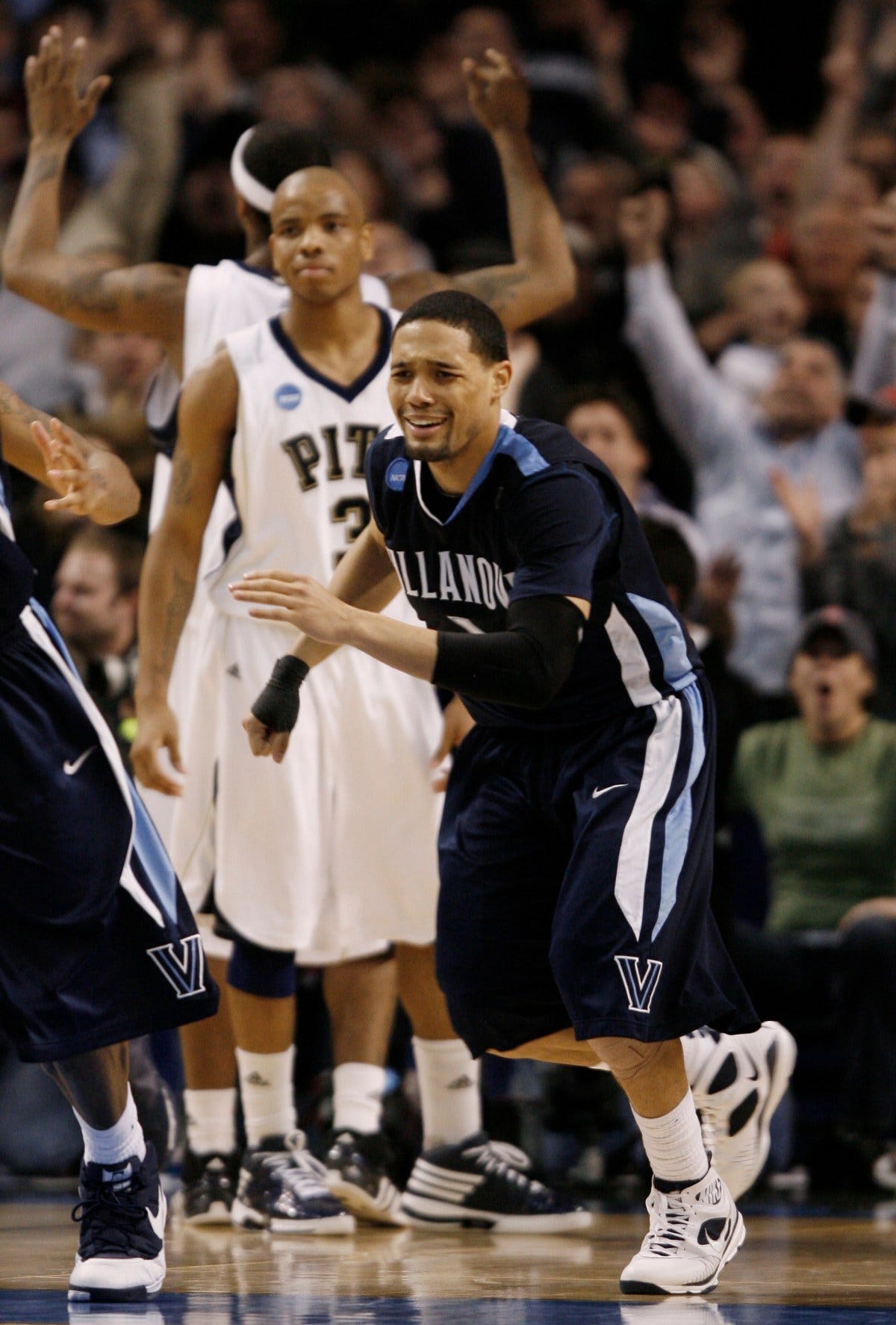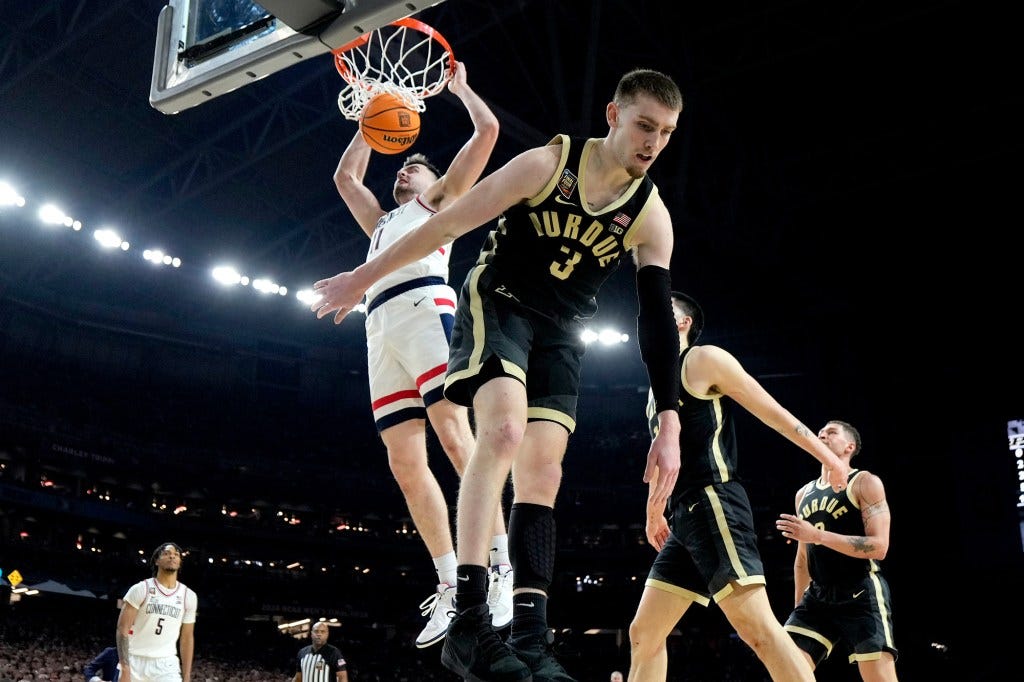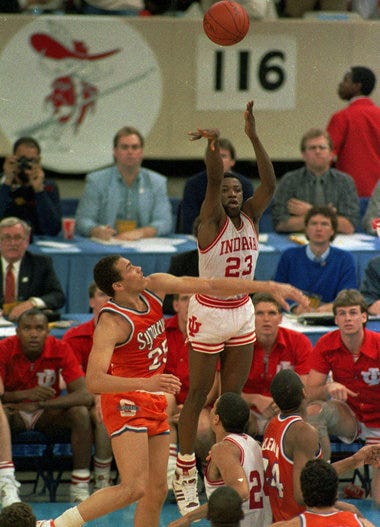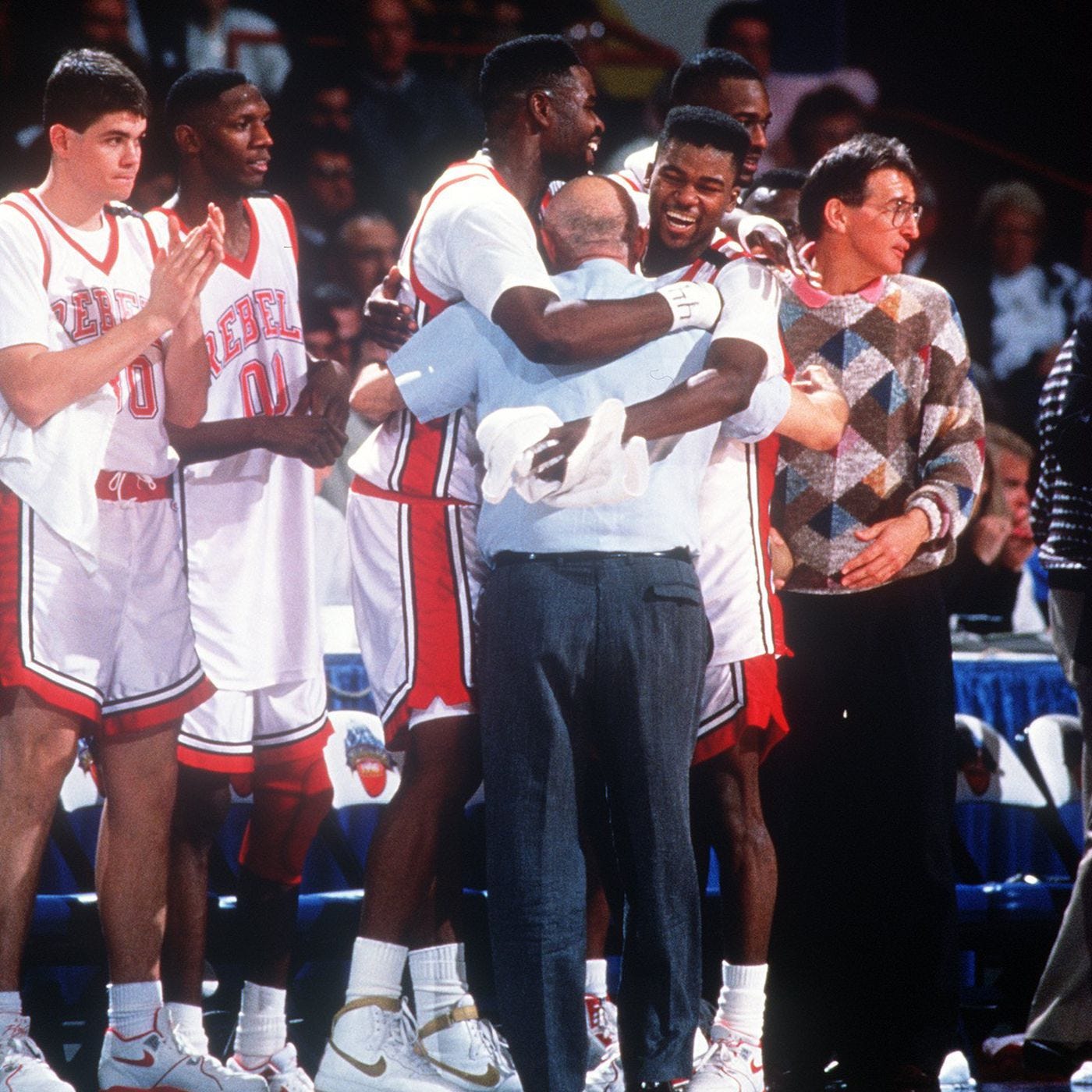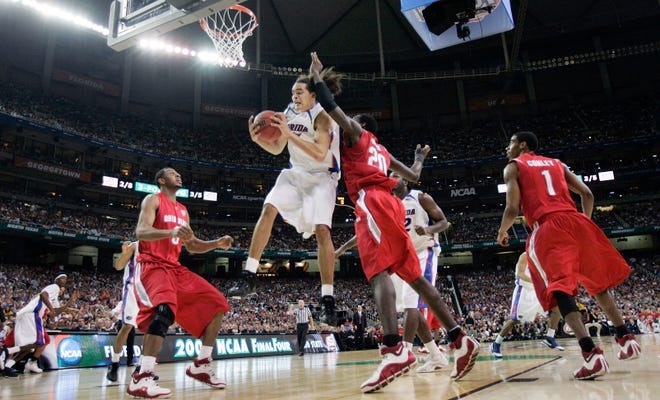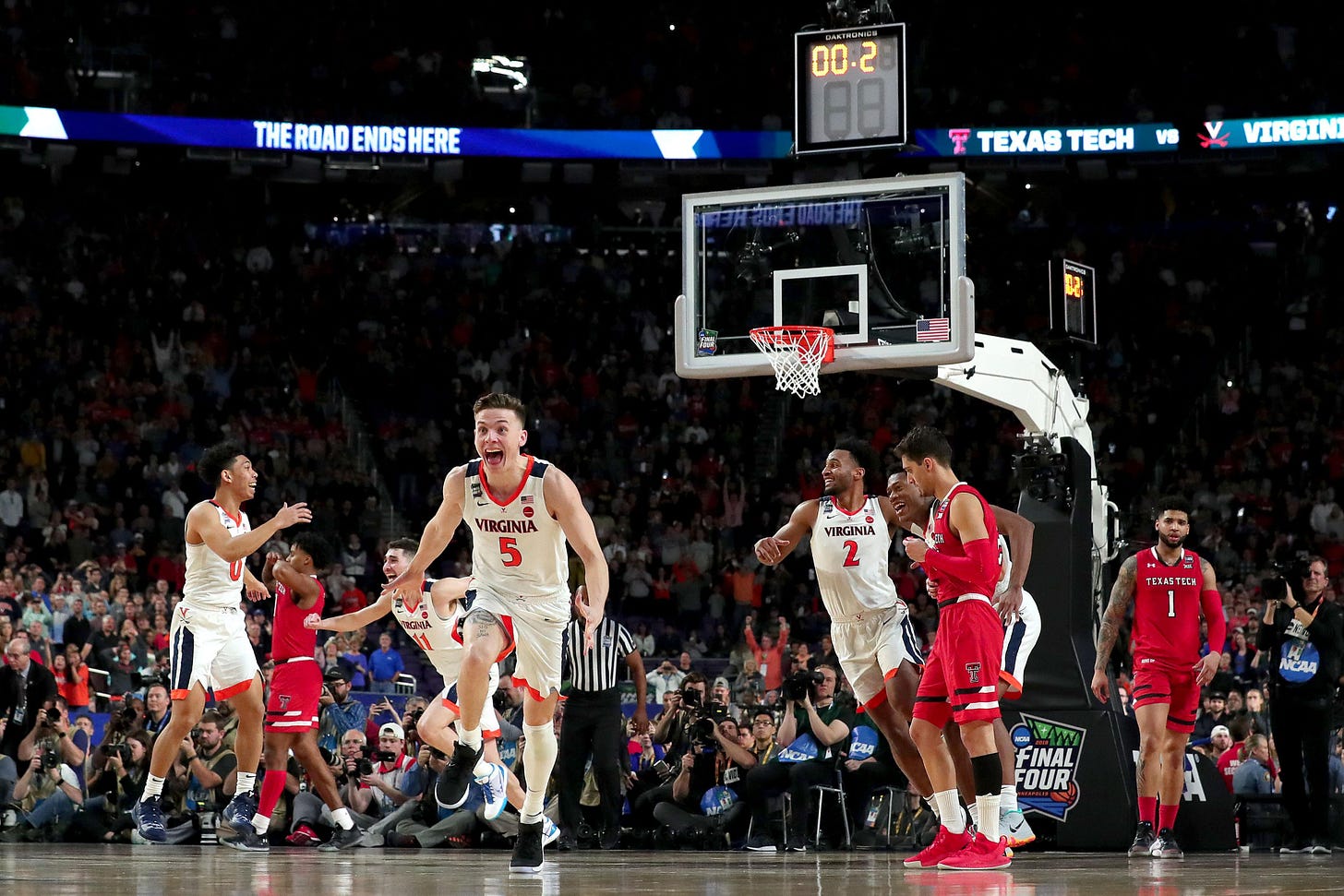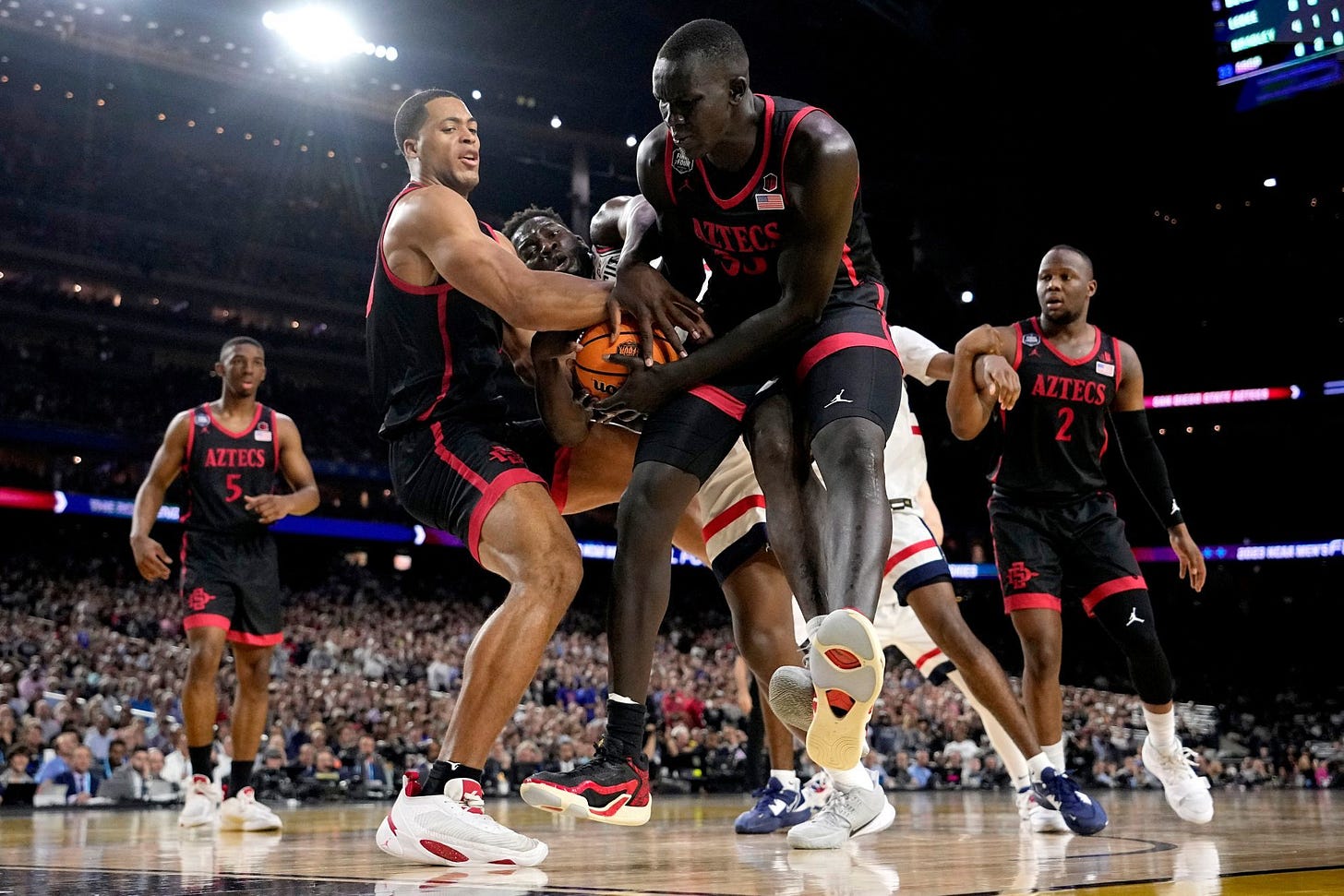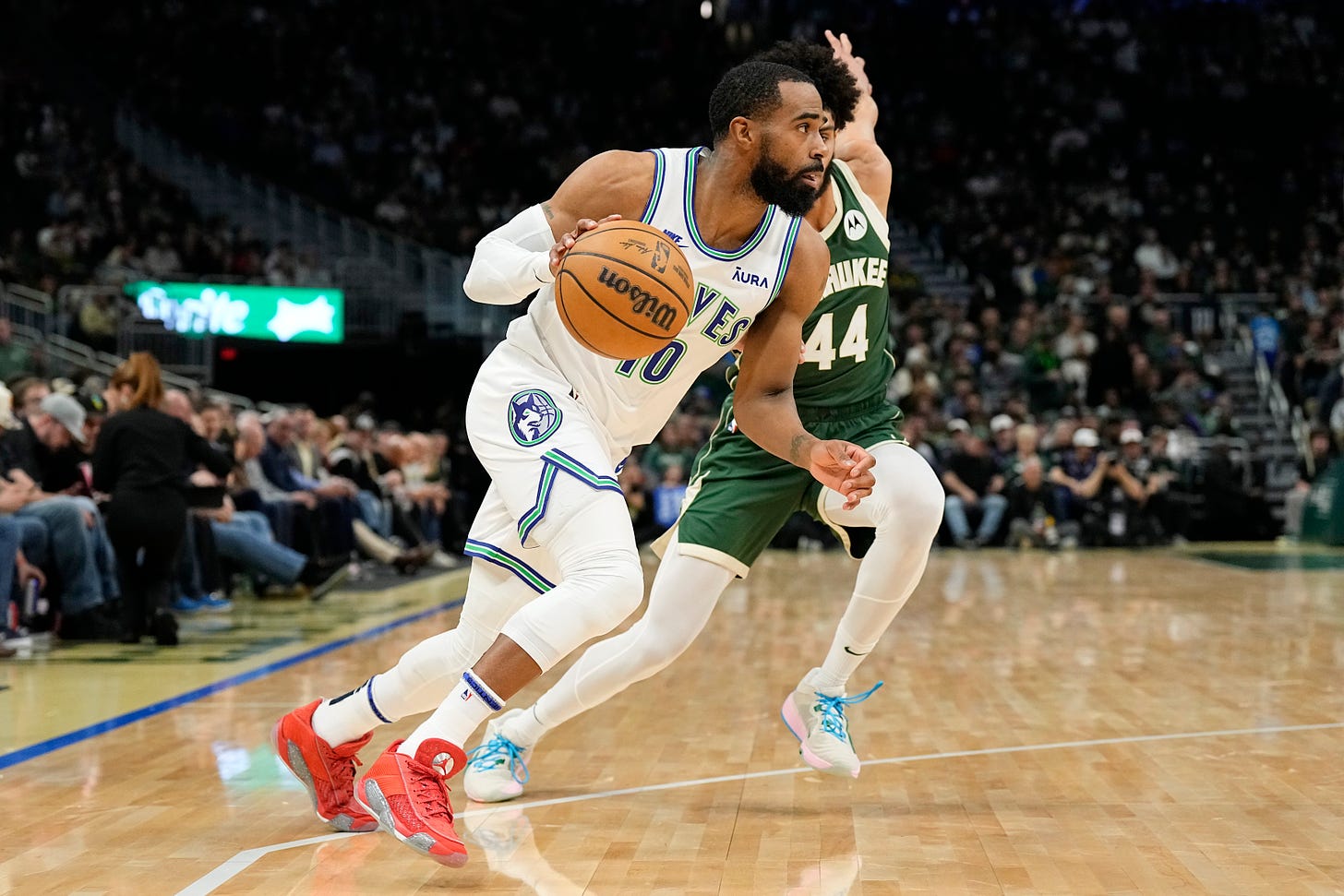When was the height of college basketball’s baggy shorts era? A Front Porch investigation
As shorts in college basketball get to a more socially acceptable length, let's revisit the excesses of the 2000s
While Shai Gilgeous-Alexander and Chet Holmgren have annoyed the country over the past two months singing (poorly) about what a pro wants – and, lest we forget, what a pro needs – there’s another AT&T commercial centered around NBA players that has captured my attention.
In the ad, Carmelo Anthony, Kendrick Perkins and T.J. Ford are sitting in (presumably) Anthony’s loft when the former Nuggets and Knicks star pats himself on the back for being someone who gives good advice. When Perkins objects to that claim, there’s a flashback to preparations for the 2003 NBA Draft, with Chingy’s wonderfully of-its-time 2003 hit “Right Thurr” playing in the background. The trio are getting fitted for comically oversized suits, the kind that were worn by all of the draft’s participants in a now iconic photo featuring some of the best basketball players of the past 20 years.
Despite objections about the bagginess of the suits, Anthony insists they’re “timeless classics,” which, of course, they turned out not to be.
It’s a wonderful spot that doesn’t even get mildly irritating after dozens of viewings, but it’s not entirely accurate. While many of us, including those involved in the 2003 Draft, now look back on those suits and laugh, there was no second-guessing about wearing them at the time. During that particular stretch in American history, it was the look – evidenced by the music video for the aforementioned “Right Thurr” – and because of that, there's no doubt that Anthony, Perkins and Ford wore those outfits enthusiastically.
It was hardly limited to them or that fateful draft night (or those fateful visits to various tailors). Boxy boys were everywhere during that time, including in the broader basketball culture. Ford’s rookie card featured him wearing a uniform better suited for a 6-foot-8 power forward than a six-foot center, which, based on a story Ford has told in recent years, appears to be the case, with the Milwaukee Bucks sending along an incorrectly sized uniform.
Perhaps the most famous distillation of that on-court fashion came from Marques Green of St. Bonaventure, whose JNCO jean-looking brown shorts damn near over up his ankles.
Even more relatively modest examples are astounding. While reporting on a 10-year retrospective piece on Pitt’s 2009 Elite Eight team, I repeatedly watched the Scottie Reynolds buzzer-beater that ended the Panthers’ season and, more than anything else, wondered how he got 94 feet up the court and weaved through one of the nation’s best defensive teams in five seconds looking like this (and with material that’s much heavier than it is today).
As someone who came of age during that era and wore some of the same kinds of roomy jerseys and shorts, I look back on the aesthetics of those years with a certain morbid curiosity. Some images, moments and subjects you come across in life simply stay with you and this, inexplicably, is one of those things for me.
All of this brings me to early last month, when UConn was putting the finishing touches on its win against Purdue and its second-consecutive national championship. With the Huskies’ victory assured, I found myself intrigued by something that had little, if anything, to do without the game itself – the length of players’ shorts.
For many of the most prominent players who suited up that night – from UConn’s Donovan Clingan and Alex Karaban to Purdue’s Zach Edey and Mason Gillis – their shorts went well above their knee, a stark contrast to the shorts I grew so accustomed to seeing as a young basketball fan.
While it got me somewhat wistful for a bygone era, it mostly piqued my curiosity. When did we get to this point, with shorts getting somewhere closer to what they were for much of the sport’s history? And, with the era of oversized jerseys now undeniably over, when did we reach peak bagginess?
Like any journalist worth their salt, I went looking for answers.
When did the shorts get so long? And when did that reverse course?
For much of basketball history, going back to when James Naismith first hung a peach basket in a YMCA in Springfield, Mass., shorts were worn a certain way. They were, in a word, short.
It goes beyond grainy, black-and-white footage. As recently as the late 1980s, the bottom halves of a basketball player’s uniform were quite revealing. Here’s a shot from the 1987 NCAA championship game, the one in which Keith Smart famously hit a baseline jumper to give Bob Knight his final title.
Look at those Daisy Duke-looking things.
Within a decade, though, shorts worn by top players were triple that length. When did that change arrive?
Before we delve into that, a little methodology. To get an insightful peek at the fashion of a given year while also being as efficient as I could be, I pored over pictures and looked at videos of every Final Four and national championship game from the past 40 years to get a sense of when trends started to emerge. Those four teams in a given year tend to reflect the stylistic choices of that time. In some special cases, those teams and its players were trendsetters, those who changed the larger culture rather than simply reflecting it.
This is also through the naked eye of one relatively sleep-deprived father of a 14 month old. I don’t know how much good it would have done anyone for me to break out a ruler and measure on the screen the length from the bottom of the shorts to the knee like I’m a nun at a Catholic high school.
Though the jerseys worn in that Indiana-Syracuse title game in 1987 would have blended in perfectly 30 years earlier, the late 1980s are when we started to see a shift in players’ on-court attire.
Michigan is often credited as the forerunner of baggy shorts in college basketball, but it was the Wolverines’ 1989 national championship team – not their 1992 or 1993 runner-up squads – that wore some noticeably looser-fitting uniforms when they beat Seton Hall in overtime to win the program’s first and only title.
That change, while certainly noticeable, was only a nudge in the baggier direction. A real push came the following year with UNLV, when it curb-stomped Duke in the 1990 championship game and did so in the kinds of jerseys and shorts never seen before on that stage. Like a handful of things that are often credited to Michigan’s Fab Five – namely, longer shorts and an inextricable tie to hip-hop culture – someone else did it first. In this case, it was the Runnin’ Rebels.
Whether intentional or not, it set off a trend. It would be two decades before shorts ever got shorter and jerseys ever got less roomy, with Syracuse’s next title game appearance after 1987, this one in 1996 against Kentucky, offering the starkest evidence yet of how quickly the times had changed.
While sometimes imperceptible at first glance, shorts got increasingly longer following that 1990 UNLV-Duke game on. But when did that upward climb reach its apex?
There is no shortage of qualified options.
Maryland’s 2002 national championship team gave us some admirably long shorts, but Indiana, less than two years removed from the end of Knight’s tenure, messed things up a bit in the title game with some several-inches-above-the-knee bottoms. About three months before he was drafted, Anthony’s Syracuse squad and the Kansas team it defeated for a championship had roomy get-ups. UCLA and Florida in 2006 gave us another strong contender.
It was another Gators championship, however, that gives us our historical victor, the point in time in which college basketball shorts drooped to a length that has never been exceeded.
In 2007, 12 months after it thumped UCLA for its first-ever national championship game, Florida made it back to the Final Four, where it once again knocked off the Bruins. In the title game, it faced off against an Ohio State team with one of the most decorated freshman classes of all-time, headlined by top-20 recruits Greg Oden, Mike Conley Jr. and Daequan Cook.
The Gators’ shorts were just a bit longer than they were the previous year, perhaps weighed down by the extra hardwear they earned or the enormous expectations they carried, but what really put this game over were the Buckeyes.
Likely no image sums it up better than this one:
Just look at Conley’s shorts, acting as a sort of parachute as he elevates.
Beyond this season, there were other possibilities. The following year’s classic title game between Kansas and Memphis (picture included at the top of this post) offered a compelling alternative, particularly from the Tigers’ side. Maybe that extra material bogged them down and prevented them from sinking a free throw or two in the waning seconds to ice the game. Or perhaps if Mario Chalmers didn’t have those extra treads weighing him down, he would have hit the heel of the rim on his game-tying 3-pointer.
As the years progressed, the shorts remained long, even if they never quite reached what Conley, Oden and company managed in 2007. Eventually, though, the pendulum began to swing back to a more modest direction.
As we got to the late end of the 2000s, Nike came out with tighter-fitting jersey tops, though the shorts remained long, creating a pretty hilarious visual. By the 2016-17 season, Nike outfitted some of its top programs with a slim jersey and shorts featuring a European cut near the bottom.
Those alterations from the sneaker giant soon permeated much of the rest of the sport.
By the mid-2010s, Final Fours regularly featured teams with players whose shorts were above their knees. There was a noticeable shift at the highest level of the sport in 2019, when Virginia and Texas Tech offered up more leg than we had seen in a generation.
The following season, Lester Quinones began his college career at Memphis while wearing his shorts to a John Stockton-like length, much to the amusement of fans and confusion from his coach, Penny Hardaway, who wore longer shorts when he starred at the school a quarter-century earlier.
“Those shorts, though,” Hardaway said in 2019 while shaking his head and smiling, according to the Memphis Commercial-Appeal.
“I just … I … the shorts. I mean, that’s like, his era,” he added, while pointing at Memphis director of player personnel Dwight Boyd, who played for the Tigers in the mid-1980s.
Quinones, for his part, said the shorts were “just kind of my thing."
Even the COVID-19 pandemic couldn’t halt the upward march of the college basketball shorts. Title games from 2021, 2022 and 2023 all offered a glimpse of where on-court aesthetics in the sport were trending, even before we got to whatever arbitrary milestone UConn’s rout of Purdue established.
What’s old is new again, in life and basketball shorts
Moving away from the days of Ford and Green was inevitable.
It never made much sense for athletes whose success depended on their ability to move with speed, burst and agility would put themselves at a potential competitive disadvantage by donning heaving uniforms, though if the other team is doing the same, I suppose it evens the playing field.
Besides, wouldn’t young athletes who spend a grueling number of hours sculpting their bodies want to show them off a little bit?
Though tights that many players wear under their shorts can mute the difference in the size of shorts, the change over the past 10-20 years is apparent for virtually any basketball game you watch. Just look at Conley, the poster boy for this exercise who’s now 36 years old and in his 17th NBA season.
Fashion is cyclical, something even a washed dad like myself who spends the majority of his waking hours in shorts and a hoodie understands. JNCOs, the astonishingly baggy jeans and jean shorts that were a must-have piece of clothing in the 1990s? They’re among the most in-demand items at thrift stores.
It goes beyond fashion, extending to taste in film and music. To cite one example, nu metal, the amalgamation of hard rock and hip-hop that was a bafflingly dominant presence on the Billboard charts and TRL at the turn of the century, is experiencing a wave of newfound popularity among Gen Z listeners. Something that was once en vogue never truly disappears. It just lingers beneath the surface, waiting for its moment to rise again.
It’s doubtful we’ll ever return to the days of the hip-huggers that were omnipresent at all levels of the sport until the late 1980s and it’s perhaps just as unlikely we’ll ever see a repeat of the 2003 NBA Draft again, whether on or off the court.
Maybe this time around, that beautiful in-between, something similar to what we’ve seen the past few Final Fours, can stick around for more than a few years. But even if it doesn’t and those knees once again get covered, it at least gives us a good excuse to dust off an old Chingy CD.
(Photos: Getty Images, St. Bonaventure Athletics, Associated Press, USA Today)

